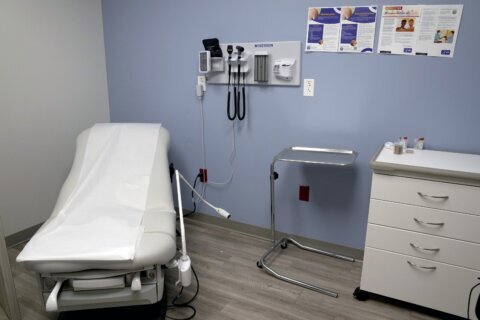SACRAMENTO, Calif. (AP) — California regulators proposed major changes to the state’s booming residential solar industry Monday, including reducing the discounts homeowners with rooftop solar and storage systems get on their electric bills when they sell extra energy back to the power companies.
California’s successful program to get more people to put solar panels on their homes has been at the center of a fierce debate between the state’s major utilities and the solar industry, and the California Public Utilities Commission’s proposed reforms have been highly anticipated.
The state’s three major utilities — Pacific Gas & Electric, San Diego Gas & Electric, and Southern California Edison — say the savings solar customers get now are so great that those customers no longer pay their fair share for the operation of the overall energy grid.
The CPUC’s proposal would reduce the incentives for going solar and roughly double, to 10 years, how long it takes Californians to make back what they paid to install the systems. Buying rooftop solar panels and a system to store extra power costs about $40,000, according to the solar industry.
The CPUC said the reforms are designed to make the program, known as “net energy metering,” more cost effective and to ensure energy grid operation costs are shared fairly. But the solar industry and its allies warned the changes will make it harder for the state to achieve its clean energy targets, including generating 100% of retail electricity from renewable or zero-carbon sources by 2045.
“The proposal will move us backward on clean energy and block many Californians’ ability to help make our grid more resilient to climate change,” Susannah Churchill, western senior regional director for Vote Solar, a political advocacy group that pushes for clean energy adoption.
California launched the program in 1995 with the goal of encouraging more homes to go solar. It worked. California now has 1.3 million solar systems on homes, far more than any other state, according to the solar industry. That number will only grow because since 2020 all newly constructed homes in California must have solar panels.
But as solar panels proliferated, and the cost of installing them went down, criticism of the program grew. The three major utilities say the current setup allows solar customers to sell their energy back into the grid for more than it’s worth. They say more needs to be done to make sure solar customers — most of whom still rely on power from utilities once the sun goes down — are paying for all the parts of the energy grid they use.
Power rates include many costs unrelated to energy generation, like transmission, distribution and even wildfire prevention work. When solar households pay significantly lower electricity bills — or no bills at all — they’re contributing less to those things. That means more of the cost is shouldered by other customers, often households and renters without the financial means to install solar.
The utilities and the state peg that cost at $3 billion. The solar industry disputes that number, saying it doesn’t take into effect the savings for everyone when the utilities need to build fewer power plants and transmission lines due to more residential solar.
The CPUC’s proposal would still allow residential solar customers to sell their excess energy back to the power companies, but at a significantly lower rate. Solar customers would also have to pay a grid charge based on how many kilowatts of energy they produce; it would cost $40 to $50 for most homes.
The charges aren’t as great as what the utilities wanted. Pacific Gas & Electric spokeswoman Ari Vanrenen called the proposal a “step in the right direction to modernize California’s outdated rooftop solar program.” But she indicated the utility — the state’s largest — would like to see regulators put higher charges on rooftop solar customers, but she declined to give specifics.
Southern California Edison said the proposal would reduce the burden on non-solar customers. San Diego Gas & Electric declined to comment, with spokesman Anthony Wagner saying the utility needed more time to review the proposal.
CPUC Commissioner Martha Guzman Aceves said the reforms are aimed at creating fairness while ensuring the financial benefits are still strong enough to encourage people to go solar. Regulators also proposed creating a $600 million fund to help low income households afford solar and storage.
The changes would apply to new solar customers, but the new charges would be phased in over four years. People who already have panels on their homes wouldn’t operate under the new system until they’ve had their panels for 15 years. If they take advantage of a roughly $3,200 subsidy to build storage systems, they would move onto the new rate structure right away.
Residential rooftop solar reduces the demand on the electric grid up to 25% during the day, according to the CPUC. But California’s peak household energy demand is from 6 to 9 p.m., when the state is mostly relying on fossil fuels to power the energy grid.
The CPUC’s proposal encourages people who already have solar panels to switch to storage by raising the power rates during those peak evening hours. And it would allow anyone with rooftop solar to install panels that provide up to 150% of the power they typically need. That would encourage people to switch to electrical appliances or buy electric cars they can charge at home, CPUC Commissioner Guzman Aceves said.
“How do we transform a program that’s about distributed solar — capturing the sun — to a program that has to do with a period when the sun is down?” Guzman Aceves said. “That’s what this reform is about.”
But the solar industry warned the higher costs will discourage people from going solar in the first place, said Bernadette Del Chiaro of the California Solar and Storage Association, which represents 700 businesses in the industry.
“If you make solar more expensive, you make the battery more expensive. It is that simple,” she said.
The CPUC commissioners could change the proposal before voting on it early next year.
Copyright © 2024 The Associated Press. All rights reserved. This material may not be published, broadcast, written or redistributed.







